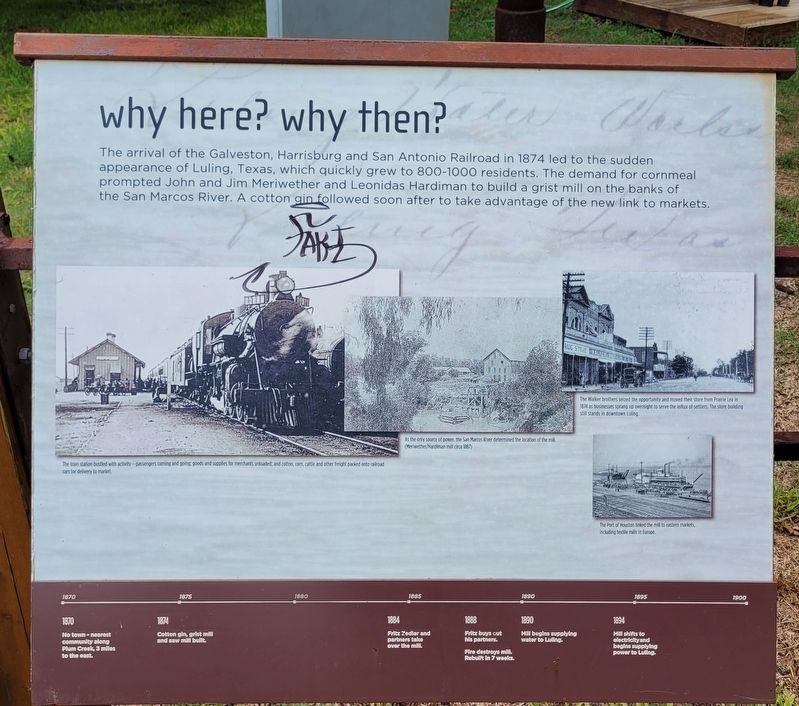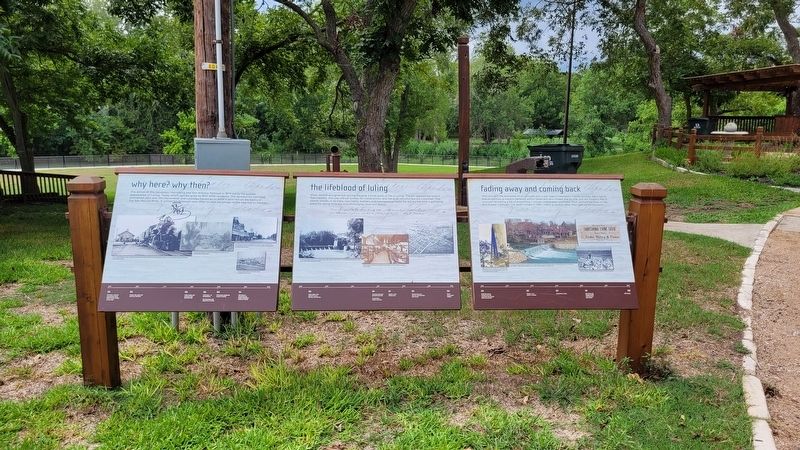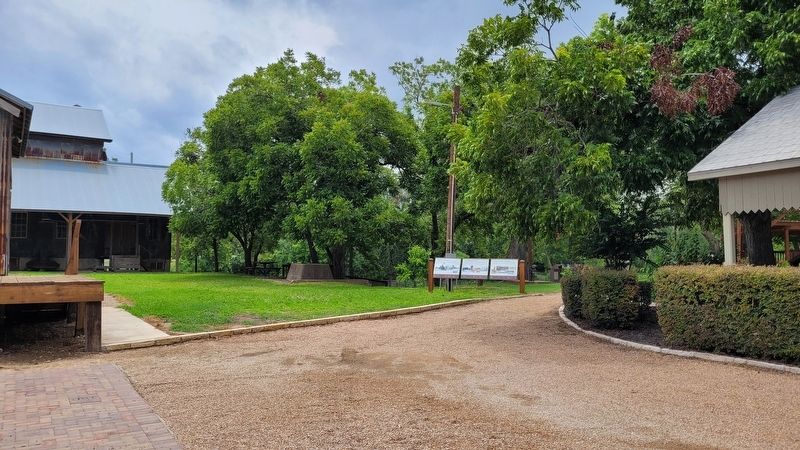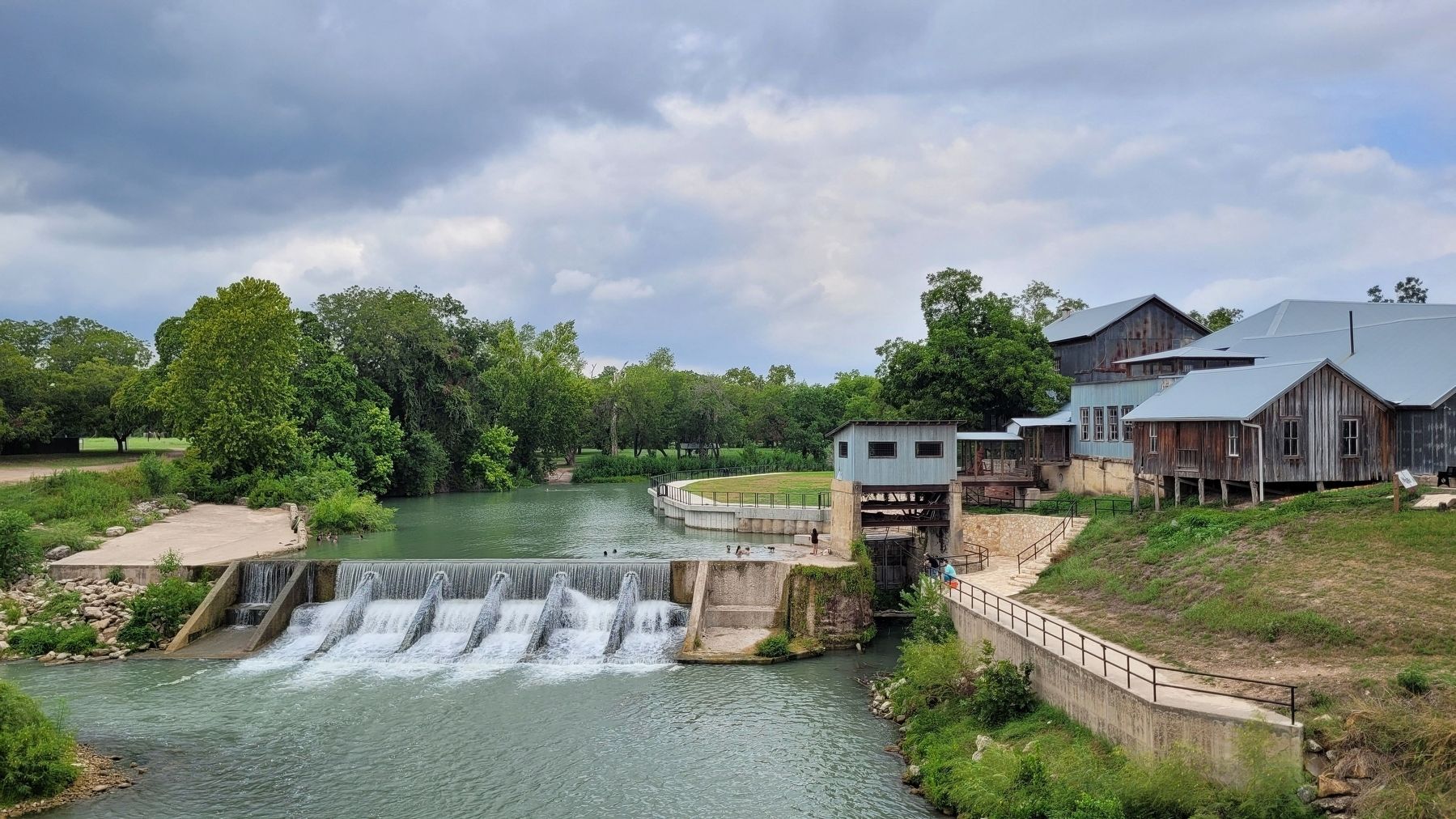Luling in Caldwell County, Texas — The American South (West South Central)
Why Here? Why Then?
Captions
Lower Left: The train station bustled with activity-passengers coming and going, goods and supplies for merchants unloaded, and cotton, corn, cattle and other freight packed onto railroad cars for delivery to market.
Middle Lower: As the only source of power, the San Marcos River determined the location of the mill. (Meriwether/Hardiman mill circa 1887)
Middle Right: The Walker brothers seized the opportunity and moved their store from Prairie Lea in 1874 as businesses sprang up overnight to serve the influx of settlers. The store building still stands in downtown Luling.
Lower Right: The Port of Houston linked the mill to eastern markets, including textile mills in Europe.
Timeline
1870
No town - nearest community along Plum Creek, 3 miles to the east.
1874
Cotton gin, grist mill and saw mill built.
1884
Fritz Zedler and partners take over the mill.
1888
Fritz buys out his partners. Fire destroys mill. Rebuilt in 7 weeks.
1890
Mill begins supplying water to Luling.
1894
Mill shifts to electricity and begins supplying power to Luling.
Erected by Zedler Mill Museum and Park.
Topics. This historical marker is listed in these topic lists: Agriculture • Parks & Recreational Areas • Railroads & Streetcars. A significant historical year for this entry is 1874.
Location. 29° 40.035′ N, 97° 39.093′ W. Marker is in Luling, Texas, in Caldwell County. Marker can be reached from the intersection of South Laurel Avenue and South Magnolia Street (State Highway 80). The marker is located in the central section of the Historic Zedler Mill Museum and Park. Touch for map. Marker is at or near this postal address: 1170 South Laurel Avenue, Luling TX 78648, United States of America. Touch for directions.
Other nearby markers. At least 8 other markers are within walking distance of this marker. The Lifeblood of Luling (here, next to this marker); Fading Away and Coming Back (here, next to this marker); From Boll to Bolt (a few steps from this marker); Mixing to Match (a few steps from this marker); Zedler's Mills (within shouting distance of this marker); Going with the Grain
(within shouting distance of this marker); Responding to a Looming Need (within shouting distance of this marker); Using Your 'Head' (within shouting distance of this marker). Touch for a list and map of all markers in Luling.
More about this marker. The Zedler Mill Park and its parking are free to the public daily. Donations are appreciated when visiting the Zedler Mill Museum.
Also see . . .
1. Zedler Mill Museum & Park. The City of Luling, Texas
Several mills were built along the San Marcos River during the late 1800's. The Zedler Mill, which is the only remaining example, was established in 1874 as the Luling community's grist mill. A simple stone dam was built by Leonidas Hardeman and two brothers, John and James Merriweather - all three from Tennessee. They added a cotton gin to the site in 1883 and installed a water wheel at the dam to produce power for their machine shop. It was known as the Merriweather Mill at that time.(Submitted on August 27, 2022, by James Hulse of Medina, Texas.)
2. Galveston, Harrisburg and San Antonio Railway. Texas State Historical Association
The Galveston, Harrisburg and San Antonio Railway Company was chartered on February 11, 1850, as the Buffalo Bayou, Brazos and Colorado Railway Company. Its name was changed on July 27, 1870. The Buffalo Bayou, Brazos and Colorado was the first railroad to begin operating in Texas, the first part of the Southern Pacific Transportation Company to begin operating, and the second railroad west of the Mississippi River. Between 1851 and 1860 the company completed eighty miles between Harrisburg and Alleyton and was in the process of clearing and grading a line along the east bank of the Colorado River in the direction of La Grange and Austin when the outbreak of the Civil War ended construction.(Submitted on August 27, 2022, by James Hulse of Medina, Texas.)
Credits. This page was last revised on August 27, 2022. It was originally submitted on August 25, 2022, by James Hulse of Medina, Texas. This page has been viewed 89 times since then and 14 times this year. Photos: 1, 2, 3, 4. submitted on August 27, 2022, by James Hulse of Medina, Texas.



